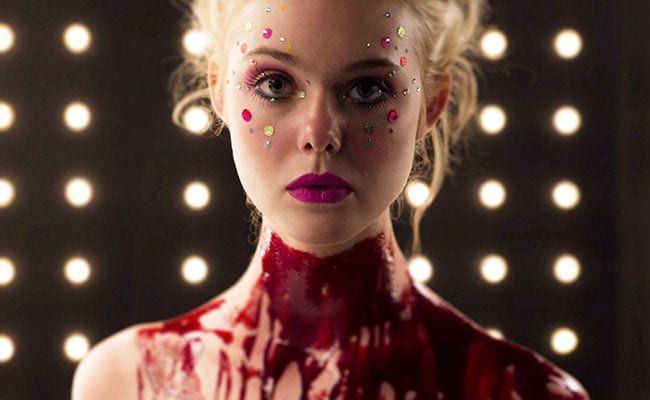
“When you see ‘Neon Demon,’ every shot, every aesthetic decision is so extreme and so confident that you’d think it’s totally planned from the beginning, but the interesting thing is that it’s not.”
“You’ve got that look. That whole deer in the headlights thing is exactly what they want.” Ruby (Jena Malone) stands across a dressing room, watching Jesse (Elle Fanning) as she works at removing a slick slather of blood-red makeup from her neck and chest. As she contemplates her wide eyes and pale skin in the mirror, Jesse fits her part, the 16-year-old newbie model just arrived in Los Angeles who’s about to learn the cruelty of the fashion industry.
Make that, the cruelty of the industry, fashion industry, a metaphor for life! Predictable and sensationalistic, the story in The Neon Demon is delivered with exclamation points. Jesse’s first appearance, in the previous scene, indicts manufacturers and consumers alike, this film’s makers and you too. As lights flash and a camera clicks, the frame pulls out, slowly, to reveal the girl draped over a love seat, a slash in her neck dripping fake blood along her slender arms, a shiny blue mini-dress packaging her like a present.
That first image sets Jesse — and you as well — within multiple frames. Designed to shock and repel you, the shot pulls out slowly to reveal frames within frames, fluorescent lights and neon lights, vivid colors and languid artifice. The critique might have to do with the seduction of violence or the exploitation of bodies, the complicity of viewers or the vulgarity of artists. You’ve seen it before.
That doesn’t stop Nicolas Winding Refn from showing it again. He’s made at least one movie about movies, about the allure of surfaces, but this one doesn’t press ahead into original insight. In this, it finds an ideal point of departure in Jesse. Posing, she may be exceptionally good at what she does (or wants to do) or perhaps just gifted, if naïve to a fault.
As she and Dean (Karl Glusman), the photographer on her first shoot, engage in a faux romance, posing one for the other on a road overlooking the city’s glittering lights, each might think the other will be their ticket, or maybe that they share an idea of the future, mutual ambition and, for lack of a better term, hope. But you also see, beyond this most rudimentary storyline, that neither Dean nor Jesse has a clue, that they’re less characters than walking signs of decadence, inviting you to judge them (as they judge one another), to feel smart and superior.
Thus, you know before they do that the world they seek to enter is represented here in lights and pretty facades, and also, always, grisly underpinnings. These typical tensions appear in a series of set-pieces. As soon as she lands in town from “Georgia”, whatever that imaginary rural nowhere might be, Jesse signs Roberta, with a top agent (Christina Hendricks), who deems her “perfect”, as she also tells her to say she’s 19. “Honey,” Roberta assures the momentarily worried Jesses, “People believe what they’re told.”
They don’t of course, but they say they do, and so, each of Jesse’s next steps fits a pattern, as she participates in shoots and auditions for famous, plainly odious male entities, as well as in escalating competition with other girls. The two girls who have names arrive by way of Ruby, whose backstage manipulations take multiple, shifting forms. Sarah (Abbey Lee) and Gigi (Bella Heathcote) immediately appear right away to be vampiric, their eyes wide but not at all naïve, their figures lithe and angly, intimidating and vulnerable. “Gigi just got out of the body shop,” offers Ruby. The four women stand in a cavernous ladies’ room, club music throbbing just outside. Gigi explains, “Plastics is just good grooming.”
Wait a beat, as the close-up cuts from Gigi to Jesse, executing her deer-in-the-headlights look. Exquisitely shot by Natasha Braier, The Neon Demon makes precise use of framing and distance, vivid colors and lots of mirrors. Each juxtaposition, each reflection, encourages your own detachment, your appreciation of its sometimes breathtaking beauty and your repulsion by these superficial creatures. Jesse’s first night on a runway produces a brilliant, if obvious, set of images, as she’s framed by lights, surrounded and then seemingly swallowed by mirrors. Apparently awed by her own image, Jesse begins to kiss it, pressing herself more and more passionately against the surface that is her.
Okay, you get this. You get that any semblance of plot is beside the point, that no one evolves or learns a lesson or really, endures much punishment that you might recognize. You also understand that The Neon Demon deploys some icky metaphors, designed to shock but not challenge your assumptions. These include bits of necrophilia and cannibalism, as well as occasional appearances by the rough-tradey manager of Jesse’s motel, Hank (Keanu Reeves), who saves her from a wildcat that breaks into her room, then may or may not start stalking her. (It’s not a little strange to find yourself looking forward to a minute or so of Reeves in order to feel some sense of emotional connection, which is to say, the film sets a low bar such connection.)
These metaphors of predation may be campy or self-serious, critiques of clichés or just clichés. They reflect themselves, like halls of receding mirrors. As gorgeous — or grotesque — as the movie’s extravagant scenarios may be, they’ve got a familiar look.


![Call for Papers: All Things Reconsidered [MUSIC] May-August 2024](https://www.popmatters.com/wp-content/uploads/2024/04/all-things-reconsidered-call-music-may-2024-720x380.jpg)



